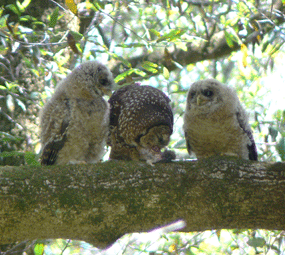
NPS Owl Ecology in Marin County, California: Vital indicators of diversity, Northern Spotted Owls have been called an “indicator” species because their presence in a forest is a gauge of the ecological health of the habitat. When an area is suitable for the Spotted Owl then it is able to support a diversity of other plants and animals. The National Park sites within Marin County support a dense population of Northern Spotted Owls. The persistence of the owl population indicates the diversity and vitality of the forest ecosystem.
Population: Possibly the densest population of Spotted Owls anywhere is found on public lands in Marin County. To date, more than 80 pairs of Spotted owls have been found in the county, with owls detected at over 100 different locations. Northern Spotted Owls are not communal birds. They hunt only in their own territory. The size of the prey population determines how close owls will nest to one another. In areas where prey is scarce the owls need to defend larger territories to have enough resources to breed, and thus build their nests far apart. The closeness of the nests in the parks indicates an abundance of prey. This abundance allows the owls to use smaller hunting areas and build their nests closer to each other.
Diet: The diet of the Northern Spotted Owl provides many clues about the diversity of life in the area. To determine what the owls were eating the National Park Service funded a study of owl pellets. Pellets are the indigestible remains of the owl’s meal. The owls swallow their food whole. The indigestible parts are regurgitated out in small pellets. The pellets often contain small bits of bone which can be used to determine what was eaten. The study examined the contents of over 100 Spotted Owl pellets. These pellets were collected in 1996 and 1997 in Marin County, California. The analysis revealed that the following species made up greater than 90% of the owls diet: Dusky-footed woodrat Bush rabbit Deer mice California vole Pocket gopher
The other 10% of the diet consisted of: Virginia opossum Songbirds Shrews Moles Weasels Rats Bats Snakes Insects
The favorite prey of the Northern Spotted Owl in Marin County is the dusky-footed woodrat (Neotoma fuscipes). The presence of so many owls suggests a very large population of dusky-footed woodrats. The owl’s diet also indicates a healthy diversity of animals in the region.
Habitat: Northern Spotted Owls need large trees with existing nest structure in them. They prefer many layers of branch cover so that they can drop silently down upon their prey. Northern Spotted Owls occupy all evergreen forested habitats in Marin County, including old-growth redwood forests, as well as second growth coast redwood, Douglas-fir, bishop pine and mixed hardwood forests. Most of the coniferous forests that owls inhabit include a significant component of hardwood trees like California bay, tanbark oak, and coast live oak, but often with a limited understory of shrubs and ferns, possibly to aid in detecting prey. Spotted owls do not build their own nests, but use the abandoned nests of ravens, raptors and squirrels. They also use tree forks, cavities and the broken tops of trees. Of the nests found during monitoring surveys conducted between 1997 and 2005, 9% were cavity nests while 91% were platform nests. Nests have been found in trees ranging from 10 inches to almost 7 feet in diameter, and from 46 to 240 feet in height. The healthy population of owls found in Marin County indicates that the parks protect complex and diverse plant life within their boundaries.
Threats: While it may appear that Northern Spotted Owls are thriving in Marin County, they must contend with numerous threats unique to their presence so close to the urban fringe. Loss of habitat due to timber harvest is the primary threat in the Pacific Northwest. Northern Spotted Owls in Marin must contend with urban development along park and open space boundaries, intense recreational use within their habitat, the spread of invasive non-native trees like eucalyptus and Monterey pine, and with the potential for catastrophic wildfires. They are also at increased risk of egg predation by common ravens, whose population is expanding in the San Francisco Bay area. The recent and continuing die-off of tanbark and live oaks from Sudden Oak Death throughout Marin County may also have long-term impacts on Spotted owl prey populations. Other threats include the possible genetic isolation of the Spotted owls and the expanding range of the competing and aggressive Barred owls. Long-term research projects are essential for the National Park Service to monitor the health of the owls and the parks. |
Last updated: February 28, 2015
